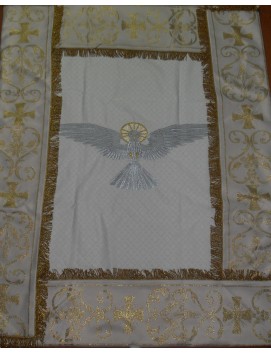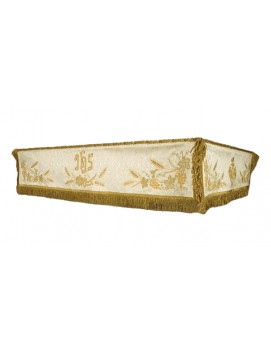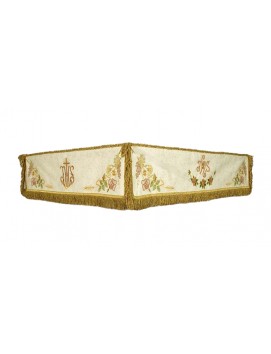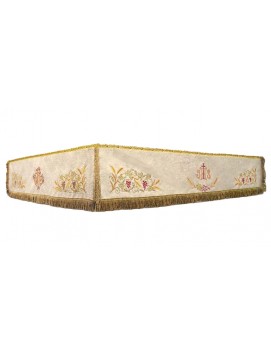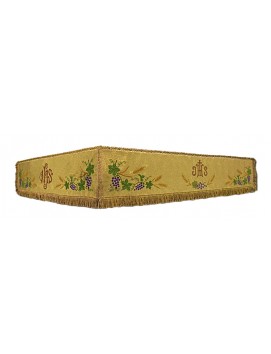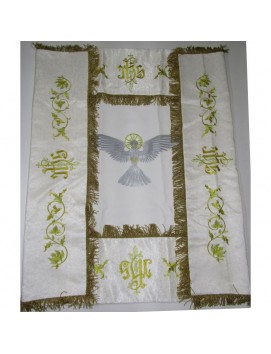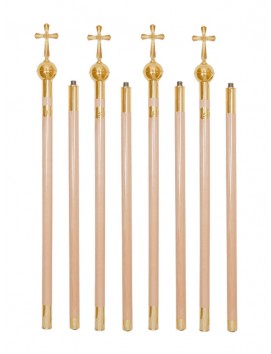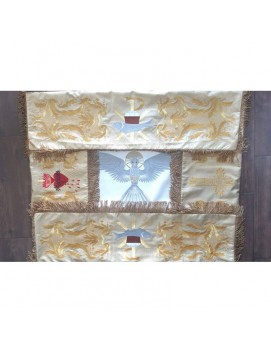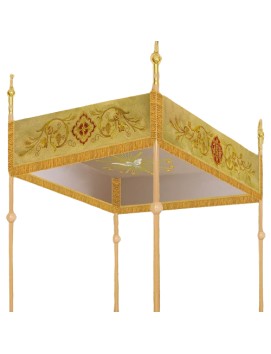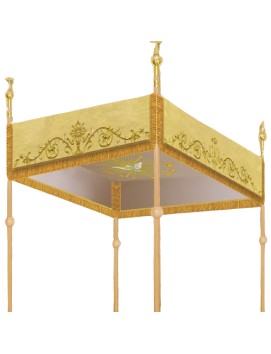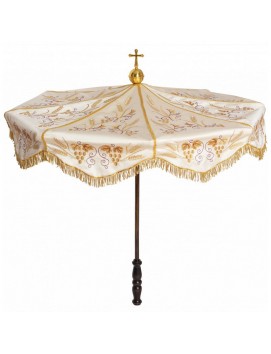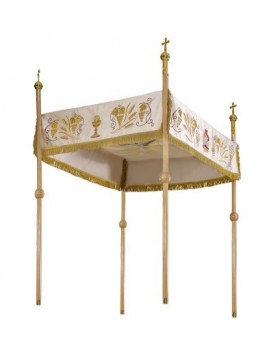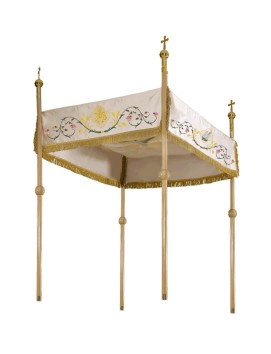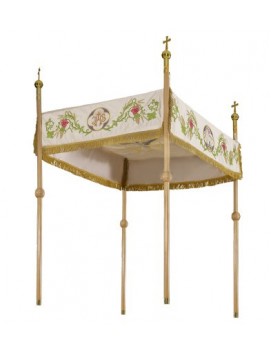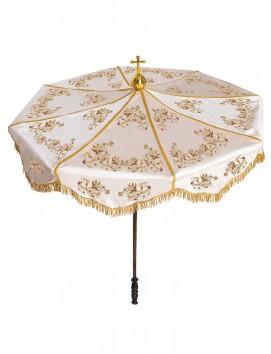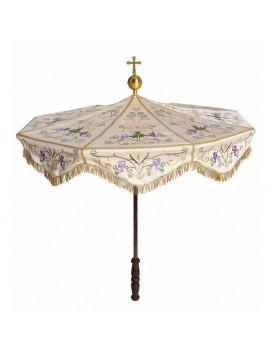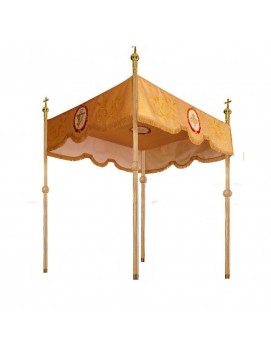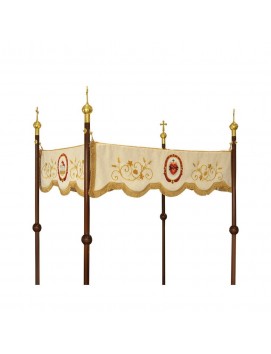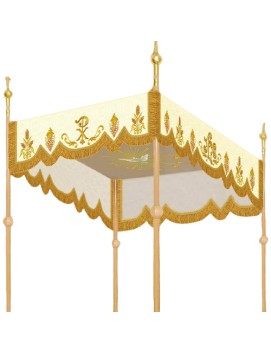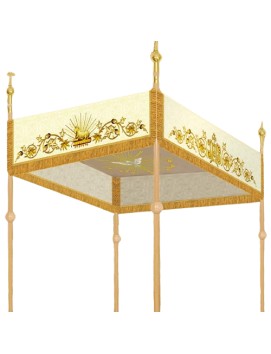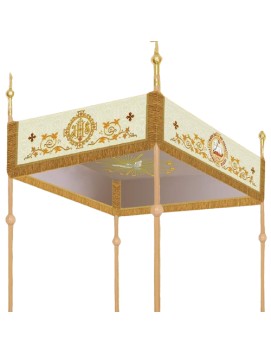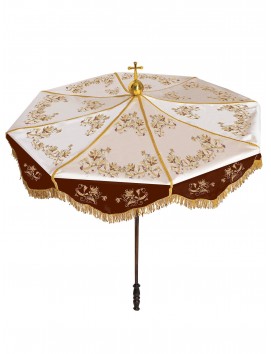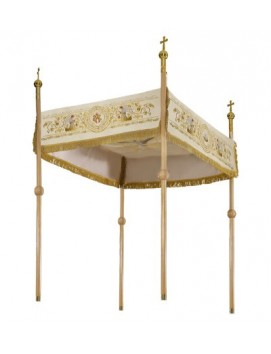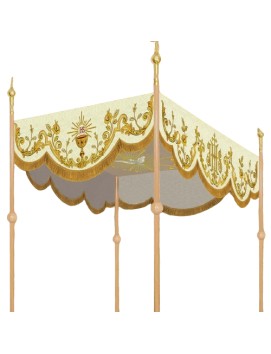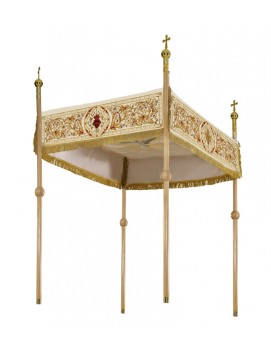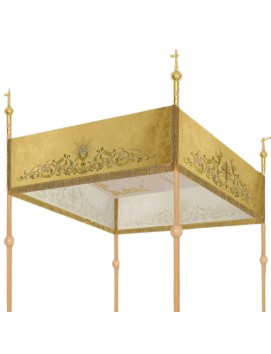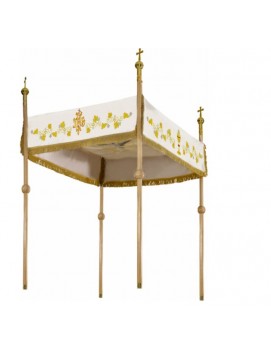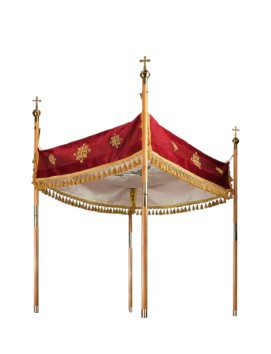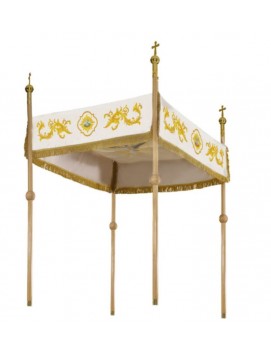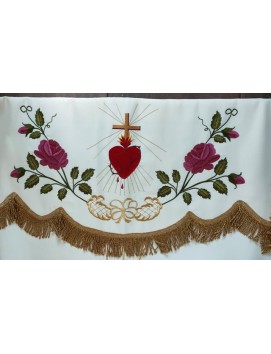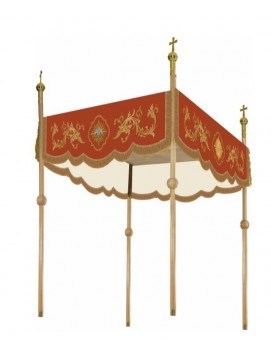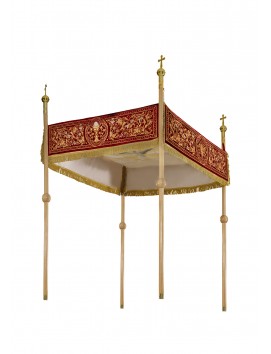Canopies
Processional canopy is a ceremonial covering used in religious, cultural, and formal events to provide shelter and symbolic significance to important figures or sacred objects during processions.
A processional canopy, also known as a baldachin or baldaquin, is typically a portable, ornate structure consisting of a canopy or roof-like covering supported by four or more poles. These canopies are often made from luxurious fabrics such as silk, velvet, or brocade, and may be adorned with intricate embroidery, tassels, or religious symbols.
Processional canopy is a ceremonial covering used in religious, cultural, and formal events to provide shelter and symbolic significance to important figures or sacred objects during processions.
A processional canopy, also known as a baldachin or baldaquin, is typically a portable, ornate structure consisting of a canopy or roof-like covering supported by four or more poles. These canopies are often made from luxurious fabrics such as silk, velvet, or brocade, and may be adorned with intricate embroidery, tassels, or religious symbols.
What is the name of the canopy of the Eucharistic procession?
The canopy used in Eucharistic processions is called a baldacchino or baldachin. This processional canopy is a rectangular framework of rich cloth supported by poles or staves, carried by individuals during the procession. It serves to honor and protect the Blessed Sacrament, sacred images, or high-ranking individuals, such as bishops, during solemn receptions or processions.
There are also variations of processional canopies used in Catholic liturgy:
Ombrellino: A smaller, umbrella-like canopy with a flat top, traditionally used in papal ceremonies.
Professional canopy with frame: A variation that includes a frame to keep the fabric taut and square, sometimes employing horizontal spacer bars for added stability.
These canopies are typically made from luxurious fabrics, such as brocades or damask, and can be decorated with embroidered elements, prints, and fringes. The design often features Eucharistic symbols such as the dove, cross, chalice, host, or angels.
Processional canopies are most commonly used during Eucharistic processions, especially on the Solemnity of Corpus Christi, as well as other significant religious celebrations, such as Holy Week.
What is the cover for the Eucharistic procession?
The cover used in Eucharistic procession canopy is typically a processional canopy, often referred to as a baldacchino. This canopy is a rectangular framework of rich cloth supported by poles or staves, carried by individuals during the procession. It serves to honor and protect the Blessed Sacrament, creating a sacred space around it and symbolizing divine protection and reverence.
Key Features of the church canopy:
Fabric and Design: Made from luxurious fabrics like brocade or damask, often featuring embroidered Eucharistic symbols such as the dove, cross, chalice, host, or angels.
Function: Protects the Blessed Sacrament from inclement weather and emphasizes its sanctity during outdoor processions.
Use: Commonly used during significant Catholic celebrations, such as Corpus Christi and Holy Week.
Variations:
Baldacchino: The most recognized form, used predominantly in outdoor processions.
Ombrellino: A smaller, umbrella-like canopy with a flat top, traditionally used in papal ceremonies.
What is the red and yellow umbrella in the Catholic Church?
The red and yellow umbrella you're referring to in the Catholic Church is called an umbraculum, also known as an ombrellino or conopaeum. This distinctive symbol has a rich history and significant meaning within the Church.
What is the purpose of the umbraculum?
The umbraculum serves several important functions:
It's a symbol of the Catholic Church and papal authority.
It identifies a church as a basilica, showing a special relationship with the Holy See.
Historically, it provided shade for the pope during processions.
What does the umbraculum look like?
The umbraculum typically has these characteristics:
Shaped like a canopy or large umbrella
Made of alternating red and yellow (or gold) stripes, representing traditional papal colors
For minor basilicas, it's made of yellow and red silk
For major basilicas (only in Rome), it's made of cloth of gold and red velvet
Where can you find the umbraculum?
You'll most likely encounter the umbraculum in these locations:
Prominently displayed on the right side of the main altar in basilicas, worldwide
As part of the coat of arms of the Holy See during sede vacante (between papal reigns)
In processions, especially during significant events like Corpus Christi
What's the significance of the umbraculum?
The umbraculum holds deep symbolic meaning:
It represents a basilica's readiness to welcome the Pope
It symbolizes the church's special connection to the Pope and the universal Church
In modern usage, it's a visual reminder of the papal authority and the church's status as a basilica
Although the umbraculum is less commonly used in daily practice, it remains an important symbol in Catholic tradition, particularly in basilicas around the world.
What is the History and Tradition of the canopy of the Eucharistic procession?
The canopy used in Eucharistic processions, often referred to as a baldacchino, has a rich history and deep-rooted tradition within Catholic liturgy. It symbolizes reverence, honor, and divine protection for the Blessed Sacrament during solemn processions, particularly on occasions like the Solemnity of Corpus Christi.
How did the tradition of the Eucharistic canopy begin?
The origins of the canopy for Eucharistic procession can be traced back to ancient civilizations, where cloth canopies were used to signify the importance of a person or object. Pharaohs in Egypt and kings in the Near East utilized such coverings as symbols of authority and protection. This practice was later adopted by European monarchs, who incorporated stationary cloth coverings over their thrones or royal beds, known as "canopies of state."
In the Christian tradition, this concept evolved into liturgical use. The mobile cloth canopy became a central feature in Catholic ceremonies, specifically designed to honor sacred objects or individuals. By the Middle Ages, it had become firmly established as part of Eucharistic processions, particularly during outdoor celebrations such as Corpus Christi.
What does the Eucharistic canopy symbolize?
The canopy serves multiple symbolic purposes:
Divine Protection: It represents God's sheltering presence over the Blessed Sacrament.
Reverence: Covering the Eucharist emphasizes its sanctity and importance.
Liturgical Heritage: The use of rich fabrics and embroidered symbols, such as doves, chalices, and wheat, reflects the Church's artistic and theological traditions.
How has the design evolved?
Over time, the design of Eucharistic canopies has become more elaborate:
Materials: Early canopies were made from fine silk (called initially "baldachin" after Baghdad silk), while modern ones often use brocade or damask with waterproof tops for outdoor use.
Structure: The baldacchino features a rectangular framework carried by multiple bearers. Variations include ombrellinos (smaller, umbrella-like canopies) used for specific purposes, such as transporting the Blessed Sacrament to the sick.
Decorations: Canopies are richly embroidered with Eucharistic symbols, such as grapes (symbolizing wine) and wheat (symbolizing bread), as well as scenes from biblical narratives, including the Last Supper and King David carrying the Ark of the Covenant.
Examples from history
Historical examples showcase how these canopies reflect their period:
A mid-19th-century canopy created in Milan featured polychrome silk embroidery depicting scenes such as the miracle of manna in Exodus and King David with the Ark, both rich in Eucharistic symbolism.
A 1911 canopy, also from Milan, highlighted neoclassical influences with grapevines, wheat shafts, and explicit Eucharistic symbols, such as a chalice and the Lamb of God.
Why is it still relevant today?
The Eucharistic canopy remains a vibrant part of the Catholic liturgy. It is not merely decorative but serves as a profound expression of faith and community. By preserving this tradition, the Church connects modern worshipers with centuries of sacred heritage while adapting to contemporary needs, such as using weatherproof materials for outdoor processions.
What are varieties of processional canopies?
There are three main varieties of processional canopies used in Catholic liturgy, each serving specific purposes during Eucharistic processions:
1. Baldacchino
The baldacchino is the most common and elaborate type of processional canopy. Its key features include:
Rectangular framework of rich cloth
Supported by four, six, or eight staves
Made from cloth of gold or white silk
Used for outdoor processions, especially during Corpus Christi celebrations
2. Ombrellino
The ombrellino is a smaller, more portable canopy:
Shaped like an umbrella, but flat instead of conical
Equipped with a long staff for carrying
Used for carrying the Blessed Sacrament to the sick
Also used to convey the Sacrament from the altar to the baldacchino
3. Framed Processional Canopy
This variation incorporates additional structural elements:
Includes a frame to keep the canopy taut and square
May employ horizontal spacer bars between vertical processional canopy poles
Designed to maintain a consistent shape during processions
These canopies are typically adorned with rich embroidery featuring Eucharistic symbols such as doves, crosses, chalices, hosts, or angels. The top is often covered with waterproof material for protection against rain during outdoor processions.
The choice of canopy depends on the specific liturgical occasion, the size of the procession, and local traditions within the Catholic Church.
What materials and fabrics are used to make the Canopy church?
The canopy used in church processions, often called a baldacchino, is typically made from luxurious fabrics and materials. Here are the key materials and fabrics used:
Fabrics
Brocade: A richly decorative shuttle-woven fabric, often used for its ornate patterns.
Damask: A reversible, patterned fabric known for its elegant designs.
Polyester with satin finish: This is A more affordable option that still provides a luxurious look.
Silk: Particularly dupioni silk, which offers a lustrous appearance.
Decorative Elements
Embroidery: Often featuring religious symbols, such as crosses, grapes, or the IHS monogram.
PVDF top layer: Applied to the outer membrane for protection against pollution and UV radiation.
Structural Components
PVC membrane: Used for both inner and outer layers in some designs.
Polyester fabric: Serves as a base for the PVC membrane.
Insulation: Some canopies incorporate insulation materials, such as Rockwool, between layers.
Additional Materials
Waterproof material: Often used on top to protect against rain during outdoor processions.
Metal framework: This is Typically made of lightweight materials to support the fabric.
The choice of materials often depends on the specific use, whether for indoor or outdoor processions, as well as the traditions of the particular church. High-quality fabrics, such as brocade and damask, are preferred for their rich appearance and symbolic value in religious ceremonies.
Are there specific colors or designs for processional canopies?
Yes, there are specific colors and designs for processional canopies, which often follow liturgical guidelines and symbolism. The colors and designs of processional canopies typically reflect the occasion, liturgical season, or specific purpose of the procession.
Colors
White: The most common color for Eucharistic processions, symbolizing purity and holiness.
Gold: Often used in combination with white or as an alternative, representing divine glory and purity.
Ecru: A light grayish-yellow color, sometimes used as a base for embroidered designs.
Liturgical colors: Canopies may sometimes match the liturgical color of the season (e.g., green for Ordinary Time, purple for Advent and Lent, red for Pentecost).
Designs and Symbols
Processional canopies often feature rich embroidery and symbolic elements:
Eucharistic symbols include the IHS monogram, a chalice with the IHS monogram, a chalice with a host, grapes, and wheat.
Religious imagery: Chi Rho sign, Sacred Heart of Jesus, Lamb of God.
Holy Spirit representation: A white dove, often depicted on the underside of the canopy.
Floral motifs: Thistles, vines, and other decorative patterns.
Passion symbols: Crown of thorns, instruments of Christ's Passion.
Materials and Structure
Fabric: High-quality materials, such as satin, brocade, or damask, are commonly used.
Embellishments: Golden fringes often frame the edges of the canopy.
Framework: Some canopies include a frame to maintain shape during processions.
The specific design and color of a processional canopy can vary based on local traditions, the preferences of the particular church, and the liturgical occasion. These canopies are not merely decorative but serve to create a sacred space and visually emphasize the importance of what they cover during religious processions.


